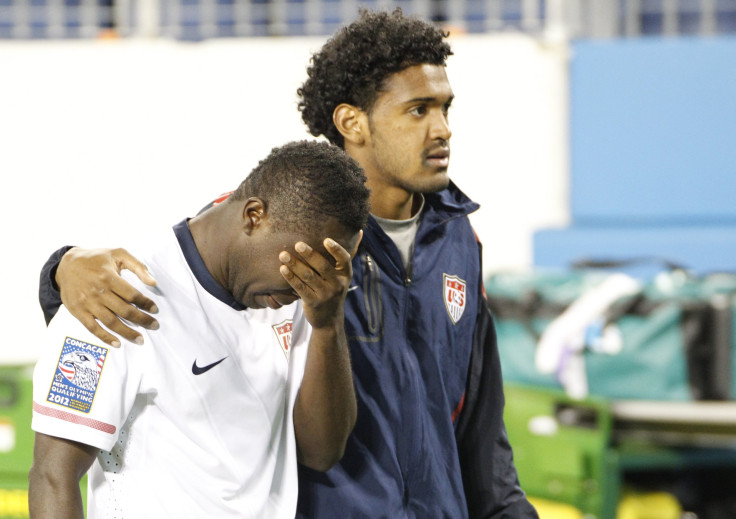U.S. Soccer Team Roster For World Cup 2014 Does Not Include Freddy Adu, What Happened To The Former Young Star?

This was supposed to be Freddy Adu’s time.
Propped up 10 years ago as the long-awaited messiah of America’s global soccer hopes at the tender age of 14, Adu’s star seemed destined to burn bright and long, and his progress was expected to time perfectly with the Yanks' run into the 2014 World Cup in Brazil.
Drawing highly ambitious comparisions to Brazilian legend Pele at a time when most teenagers are struggling more with high school algebra and an expanding social life, the attacking midfielder and sometimes forward clearly faced surreal, overwhelming expectations.
Now 25 and nowhere near the USA roster despite holding onto to hopes earlier this year, the Ghanese-American’s future seems in doubt after bouncing around Major League Soccer and Europe for the better part of a decade.
Adu’s rise and subsequent decline began on January 16, 2004 in Charlotte, North Carolina, when D.C. United made him the top overall selection in the MLS SuperDraft. Of the 60 players selected, Adu was one of two who hadn’t played in college and but were instead part of MLS’s joint venture with Nike called Project-40 (now called Generation Adidas) to elevate the level of young soccer talent across the U.S. by exposing them to the best competition at an early age.
Blessed with ultra-quick feet, a boundless motor and elusive dribbling skill, Adu became the youngest athlete to ever sign a professional contract in the United States and his promise was evident in his first three years in Washington.
United seemed the perfect place for a young talent to thrive under very little pressure, considering they won three of the first four MLS Cups. From 2004 to 2006, Adu was named to two MLS All-Star squads, totaling 11 goals and 17 assists and helping United capture the 2004 Cup his rookie year.
The wave of early success didn’t last long. Adu was elevated to United’s starting squad in 2006, but was eventually traded to Real Salt Lake in December, and that’s where the decline seemed to start.
Appearing in 11 matches and netting one goal, Adu quickly abandoned RSL for the opportunity to play among some of the world’s most elite players in Europe. Acquired by Portuguese Liga’s Benfica for a transfer of $2 million, Adu made the leap to top-flight European soccer at 18.
Benfica represented the opportunity of a lifetime, with a rich heritage of 31 domestic titles, at the time, and two European Cups over 110 years.
But over the next four years Adu took a long, arduous journey across Europe similar to a college student backpacking from hostel to hostel. He would spend year-long loans with French club titans Monaco, a stint back in Portugal with Belenenses, then Greece’s Aris and finally Turkey’s Caykur Rizespor.
Adu couldn’t find a permanent home, and after four years traipsing across Europe with five teams, he had totaled 32 appearances and scored five goals.
Adu returned to MLS by signing with the Philadelphia Union in 2011, and was reunited with his former United coach Piotr Nowak. But after 35 games and seven goals scored in two seasons, Adu’s fate with Philadelphia seemed tied to Nowak’s success. Under the Polish-born manager the Union posted a 21-30-24 record and he was dismissed following the 2012 season.
Adu’s career was starting to wane, and he signed with Brazilian club Bahia last year, only to make five total appearances in all competitions before being cut after eight months of service.
However, while Adu’s club career was floundering he had gradually moved up along USA’s international ranks, with stints with the under-17, under-20 and under-23 squads interspersed with first-team opportunities starting in 2006.
At 16, he was the youngest player ever to be capped for the U.S. in January 2006, and in 2007 he made his inaugural start for the senior team. Adu would help the under-23 squad qualify for the 2008 Summer Olympics in Beijing with four goals in the qualifying tournament in Canada, and that earned him a spot on the Olympic team. In Beijing he played in the first two matches of group play, only to be suspended for the final match against Nigeria after he was booked twice, and the U.S. was later eliminated before the knockout stages.
The 2011 CONCACAF Gold Cup was a last gasp for Adu, and a shock that he even made the roster considering his club career had reached an all-time low. He eventually made an appearance in the semifinal against Panama, helping Landon Donovan with his assist to Clint Dempsey, and earning a start in the final against Mexico. The U.S. would falter 4-2, but Adu contributed to both of his nation’s goals.
All told Adu has made 151 appearances and scored 23 goals for the U.S., but he’s been shutout of the final roster in the past three World Cups.
Following his cut by Bahia, Adu was in limbo for several months until he began training with Championship League’s Blackpool in February. Ultimately, Blackpool declined to offer Adu a contract, but allowed him to continue training in order to keep up his fitness should another offer come up.
In February, the only reported offer came from the Atlanta Silverbacks in the NASL, the American minor leagues. The club’s president and general manager made it clear publicly that they would welcome the former American hopeful, but Adu rebuffed rumors he was speaking with the Silverbacks on his Twitter account. Adu also indicated then he was still training with Blackpool and was weighing opportunities in Europe.
Clearly, Adu believes many years of top flight play lay ahead, and he’s likely right. Adu’s in the heart of his prime, and though he hasn’t met the expectations thrust upon him since he was a teenager, he’s young enough to keep his career and World Cup hopes alive.
© Copyright IBTimes 2024. All rights reserved.





















